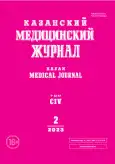Особенности иммунного и метаболомного профиля детей с избыточной массой тела, ассоциированные с полиморфными вариантами генов IL-1B и TP53
- Авторы: Долгих О.В.1, Зайцева Н.В.1, Никоношина Н.А.1, Алексеев В.Б.1
-
Учреждения:
- Федеральный научный центр медико-профилактических технологий управления рисками здоровью населения
- Выпуск: Том 104, № 2 (2023)
- Страницы: 183-191
- Раздел: Теоретическая и клиническая медицина
- Статья получена: 21.06.2022
- Статья одобрена: 22.11.2022
- Статья опубликована: 26.03.2023
- URL: https://kazanmedjournal.ru/kazanmedj/article/view/108890
- DOI: https://doi.org/10.17816/KMJ108890
- ID: 108890
Цитировать
Полный текст
Аннотация
Актуальность. Рост количества детей с избыточной массой тела — важная проблема современного здравоохранения. Избыточная масса тела обусловливает риск развития тяжёлых метаболических нарушений. Анализ изменений иммунного, метаболомного, генетического профиля детей с избыточной массой тела как маркёров раннего развития метаболических нарушений — эффективный инструмент для профилактики, диагностики и лечения данных видов патологии.
Цель. Выявить особенности иммунного и метаболомного профиля детей в возрасте 7–11 лет с избыточной массой тела, ассоциированные с полиморфными вариантами генов IL-1B (rs1143634) и TP53 (rs1042522).
Материал и методы исследования. Обследованы 132 ребёнка в возрасте 7–11 лет: 54 ребёнка с избыточной массой тела и 78 детей с нормальной массой тела. Субпопуляционный состав лимфоцитов анализировали методом проточной цитометрии; содержание лептина, кортизола, супероксиддисмутазы, гидроперекиси липидов и интерлейкина-1β — с помощью иммуноферментного анализа, иммуноглобулина G — методом радиальной иммунодиффузии по Манчини. Полиморфные варианты генов IL-1B (rs1143634) и TP53 (rs1042522) идентифицировали посредством полимеразной цепной реакции в реальном времени. Статистическая обработка данных реализована в программах Statistica 10, SNPStat и Gen-Expert.
Результаты. Иммунный профиль обследованных детей отличается повышенным содержанием CD3+CD8+-, CD19+-лимфоцитов и иммуноглобулина G на фоне дефицита CD3+CD4+-лимфоцитов, p53 и снижения количества CD4+/CD8+. Метаболомный профиль детей характеризуется избыточным содержанием лептина, кортизола, гидроперекисей липидов, супероксиддисмутазы. Выявленные изменения иммунной и метаболомной регуляции у детей с избыточной массой тела достоверно ассоциированы с G-аллелем и GG-генотипом гена IL-1B (rs1143634), а также с С-аллелем и СС-генотипом гена TP53 (rs1042522), обусловливающими инициацию воспаления и угнетение апоптоза.
Вывод. Установленные особенности иммунной и метаболомной регуляции, ассоциированные с G-аллелем и GG-генотипом гена IL-1B (rs1143634) и с С-аллелем и СС-генотипом TP53 (rs1042522), представляют комплекс маркёров формирования избыточной массы у детей в возрасте 7–11 лет.
Ключевые слова
Полный текст
Об авторах
Олег Владимирович Долгих
Федеральный научный центр медико-профилактических технологий управления рисками здоровью населения
Email: oleg@fcrisk.ru
ORCID iD: 0000-0003-4860-3145
докт. мед. наук, зав., отдел иммунобиологических методов диагностики
Россия, г. Пермь, РоссияНина Владимировна Зайцева
Федеральный научный центр медико-профилактических технологий управления рисками здоровью населения
Email: znv@fcrisk.ru
ORCID iD: 0000-0003-2356-1145
докт. мед. наук, проф., академик РАН, научный руководитель
Россия, г. Пермь, РоссияНаталья Алексеевна Никоношина
Федеральный научный центр медико-профилактических технологий управления рисками здоровью населения
Автор, ответственный за переписку.
Email: nat08.11@yandex.ru
ORCID iD: 0000-0001-7271-9477
мл. науч. сотр., лаборатория иммунологии и аллергологии, аспирант
Россия, г. Пермь, РоссияВадим Борисович Алексеев
Федеральный научный центр медико-профилактических технологий управления рисками здоровью населения
Email: root@fcrisk.ru
ORCID iD: 0000-0001-5850-7232
докт. мед. наук, проф., директор
Россия, г. Пермь, РоссияСписок литературы
- Abarca-Gómez L, Abdeen ZA, Hamid ZA, Abu-Rmeileh NM, Acosta-Cazares B, Acuin C, Adams RJ, Aekplakorn W, Afsana K, Aguilar-Salinas CA, Agyemang C, Ahmadvand A, Ahrens W, Ajlouni K, Akhtaeva N, Al-Hazzaa HM, Al-Othman AR, Al-Raddadi R, Al Buhairan F, Al Dhukair S, Lehtimäki T, Ronkainen K, Uusitalo H. Worldwide trends in body-mass index, underweight, overweight, and obesity from 1975 to 2016: A pooled analysis of 2416 population-based measurement studies in 128•9 million children, adolescents, and adults. Lancet. 2017;290(10113):2627–2642. doi: 10.1016/S0140-6736(17)32129-3.
- Баланова Ю.А., Шальнова С.А., Деев А.Д., Имаева А.Э., Концевая А.В., Муромцева Г.А., Капустина А.В., Евстифеева С.Е., Драпкина О.В. Ожирение в российской популяции — распространённость и ассоциации с факторами риска хронических неинфекционных заболеваний. Российский кардиологический журнал. 2018;(6):123–130. doi: 10.15829/1560-4071-2018-6-123-130.
- Isbit J. Preventing diseases of civilization. J Pediatr Surg. 2018;53(6):1261. doi: 10.1016/j.jpedsurg.2018.02.099.
- Долгих О.В., Зайцева Н.В., Никоношина Н.А. Особенности нейрогуморального и иммунного профиля детей с функциональными расстройствами вегетативной нервной системы, ассоциированные с полиморфизмом гена сиртуина SIRT1 (rs7069102). Бюллетень экспериментальной биологии и медицины. 2021;172(11):622–626. doi: 10.47056/0365-9615-2021-172-11-622-626.
- Романцова Т.И., Сыч Ю.П. Иммунометаболизм и метавоспаление при ожирении. Ожирение и метаболизм. 2019;16(4):3–17. doi: 10.14341/omet12218.
- Клиническое руководство Тица по лабораторным тестам. Под ред. А.Х.Б. Ву. Пер. с англ. под ред. В.В. Меньшикова. М.: Лабора; 2013. 1280 с.
- Сетко А.Г., Булычева Е.В., Сетко Н.П. Особенности развития донозологических изменений в психическом и физическом здоровье у учащихся поколения Z. Анализ риска здоровью. 2019;(4):158–164. doi: 10.21668/health.risk/2019.4.17.
- Barazzoni R, Cappellari GG, Ragni M, Nisoli E. Insulin resistance in obesity: an overview of fundamental alterations. Eat Weight Disord. 2018;23:149–157. doi: 10.1007/s40519-018-0481-6.
- Трошина Е.А. Роль цитокинов в процессах адаптивной интеграции иммунных и нейроэндокринных реакций организма. Проблемы эндокринологии. 2021;67(2):4−9. doi: 10.14341/probl12744.
- Gancheva S, Jelenik T, Alvarez-Hernandez E, Roden M. Interorgan metabolic crosstalk in human insulin resistance. Physiol Rev. 2018;98(3):1371–1415. doi: 10.1152/physrev.00015.2017.
- Carlos D, Costa FRC, Pereira CA, Rocha FA, Yaochite JNU, Oliveira GG, Carneiro FS, Tostes RC, Ramos SG, Zamboni DS, Camara NOS, Ryffel B, Silva JS. Mitochondrial DNA activates the NLRP3 inflammasome and predisposes to type 1 diabetes in murine model. Front Immunol. 2017;8:164. doi: 10.3389/fimmu.2017.00164.
- Hill S, Sataranatarajan K, van Remmen H. Role of signaling molecules in mitochondrial stress response. Front Genet. 2018;9:225. doi: 10.3389/fgene.2018.00225.
- Pfister AS. Emerging role of the nucleolar stress response in autophagy. Front Cell Neurosci. 2019;13:156. doi: 10.3389/fncel.2019.00156.
- Jo E-K, Kim JK, Shin D-M, Sasakawa C. Molecular mechanisms regulating NLRP3 inflammasome activation. Cell Mol Immunol. 2016;13(2):148–159. doi: 10.1038/cmi.2015.95.
- Liang JJ, Fraser IDC, Bryant CE. Lipid regulation of NLRP3 inflammasome activity through organelle stress. Trends Immunol. 2021;42(9):807–823. doi: 10.1016/j.it.2021.07.005.
Дополнительные файлы






